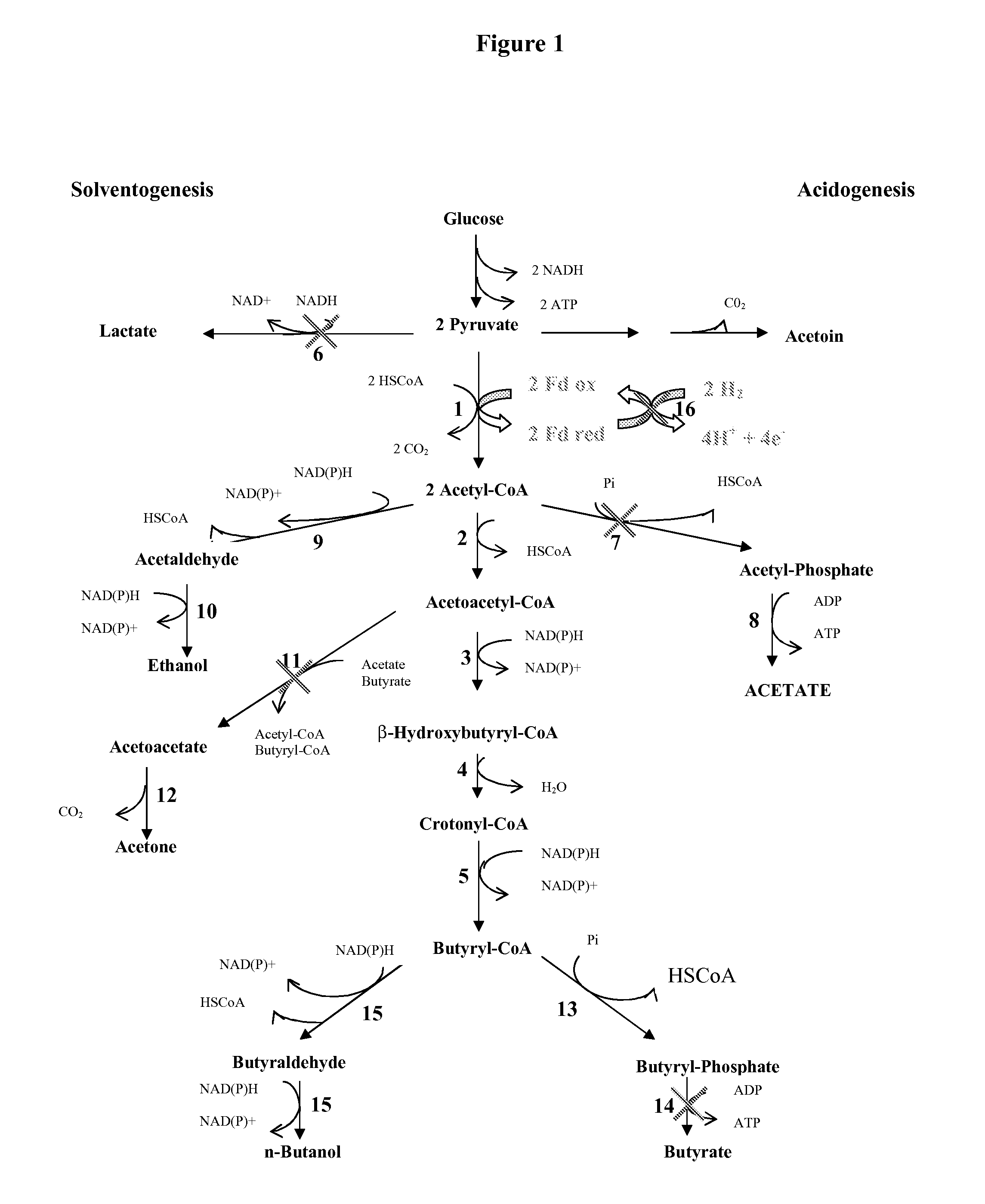PROCESS FOR THE BIOLOGICAL PRODUCTION OF n-BUTANOL WITH HIGH YIELD
a biological production and high yield technology, applied in the field of biological production of nbutanol with high yield, can solve the problem that the low titer of solvents no longer seems to be an economical limitation of the process, and achieve the effect of reducing the flux of hydrogen production
- Summary
- Abstract
- Description
- Claims
- Application Information
AI Technical Summary
Benefits of technology
Problems solved by technology
Method used
Image
Examples
example 1
Construction of Strains Unable to Produce Butyrate: Clostridium acetobutylicum Δcac1515 Δupp Δbuk
[0049]To delete the buk gene, the homologous recombination strategy described by Croux & Soucaille (2006) in patent application PCT / EP2006 / 066997 is used. This strategy allows the insertion of an erythromycin resistance cassette, while deleting most of the gene concerned. The buk deletion cassette in pCons::upp was constructed as follows.
TABLE 1primers sequencesNamePrimer sequencesBuk 1SEQ ID No 1aaaagggtcctagtaaaagggagtgtacBuk 2SEQ ID No 2ggggtcgcgaaaaaaggggggattattaBuk 3SEQ ID No 3cccccttttttcgcgaccccacttcttgBuk 4SEQ ID No 4aaaaggatcctctaaattctgcaatataBuk 0SEQ ID No 5ataacaggatatatgctctctgacgcggBuk 5SEQ ID No 6gatcatcactcattttaaacatggggcc
[0050]Two DNA fragments surrounding buk were PCR amplified with the Pwo polymerase with total DNA from C. acetobutylicum as template and two specific couples of olignonucleotides. With the couples of primers BUK 1-BUK 2 and BUK 3-BUK 4, two DNA fragme...
example 2
Construction of Strains Unable to Produce Butyrate and Acetone: C. acetobutylicum Δcac1515 Δupp Δbuk ΔctfAB
[0053]To delete the ctfAB genes, the homologous recombination strategy described by Croux & Soucaille (2006) in patent application PCT / EP2006 / 066997 is used. This strategy allows the insertion of an erythromycin resistance cassette, while deleting most of the genes concerned. The ctfAB deletion cassette in pCons::upp was constructed as follows.
TABLE 2primers sequencesNamePrimer sequencesCtf 1SEQ ID No 7aaaaggcatcccagacactataatagctCtf 2SEQ ID No 8ggggaggcctaaaaagggggattataaaCtf 3SEQ ID No 9ccccctttttaggcctccccatatccaaCtf 4SEQ ID No 10aaaaggatccgtgttataatgtaaatatCtf 0SEQ ID No 11taccaccttctttcacgcttggctgcggCtf 5SEQ ID No 12tatttaaagaggcattatcaccagagcg
[0054]Two DNA fragments surrounding ctfAB were PCR amplified with the Pwo polymerase with total DNA from C. acetobutylicum as template and two specific couples of olignonucleotides. With the couples of primers CTF 1-CTF 2 and CTF 3-...
example 3
Construction of Strains Unable to Produce Butyrate, Acetone and Lactate: C. acetobutylicum Δcac1515 Δupp Δbuk ΔctfAB Δldh
[0057]To delete the ldh gene, the homologous recombination strategy described by Croux & Soucaille (2006) in patent application PCT / EP2006 / 066997 is used. This strategy allows the insertion of an erythromycin resistance cassette, while deleting most of the genes concerned. The ldh deletion cassette in pCons::upp was constructed as follows.
TABLE 3primers sequencesNamePrimer sequencesLdh 1SEQ ID No 13AAAAGGATCCGCTTTAAAATTTGGAAAGAGGLdh 2SEQ ID No 14GGGGAGGCCTAAAAAGGGGGTTAGAAATCTTTAAAAATTTCTCTATAGAGCCCATCLdh 3SEQ ID No 15CCCCCTTTTTAGGCCTCCCCGGTAAAAGACCTAAACTCCAAGGGTGGAGGCTAGGTCLdh 4SEQ ID No 16AAAAGGATCCCCCATTGTGGAGAATATTCCAAAGAAGAAAATAATTGCLdh 0SEQ ID No 17CAGAAGGCAAGAATGTATTAAGCGGAAATGCLdh 5SEQ ID No 18CTTCCCATTATAGCTCTTATTCACATTAAGC
[0058]Two DNA fragments surrounding ldh (CAC267) were PCR amplified with the Pwo polymerase with total DNA from C. acetobutylicum as t...
PUM
| Property | Measurement | Unit |
|---|---|---|
| miscibility | aaaaa | aaaaa |
| concentration | aaaaa | aaaaa |
| concentration | aaaaa | aaaaa |
Abstract
Description
Claims
Application Information
 Login to View More
Login to View More - R&D
- Intellectual Property
- Life Sciences
- Materials
- Tech Scout
- Unparalleled Data Quality
- Higher Quality Content
- 60% Fewer Hallucinations
Browse by: Latest US Patents, China's latest patents, Technical Efficacy Thesaurus, Application Domain, Technology Topic, Popular Technical Reports.
© 2025 PatSnap. All rights reserved.Legal|Privacy policy|Modern Slavery Act Transparency Statement|Sitemap|About US| Contact US: help@patsnap.com

